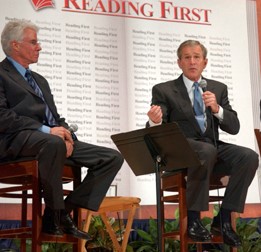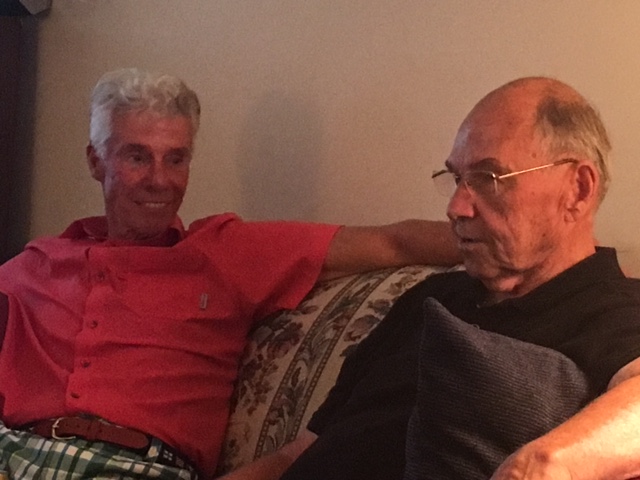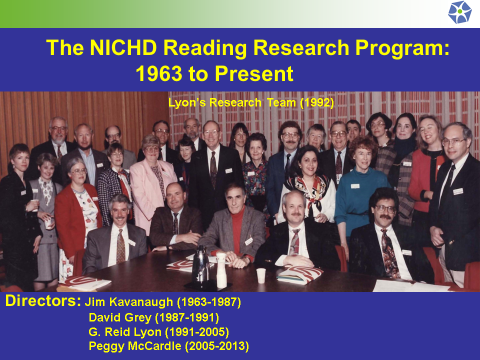What We Have Learned From 50 Years of Reading Science:
Reid Lyon’s Ten Maxims
By: Kari Kurto
Dr. Reid Lyon is a distinguished neuroscientist and researcher who has worked tirelessly to advance the science of reading. As the former head of the National Institute of Child Health and Human Development (NICHD), Reid played a pivotal role in advancing scientific research on reading and language development. He led groundbreaking studies that provided invaluable insights into the cognitive processes underlying reading acquisition and dyslexia, shedding light on the neurological and genetic factors that impact literacy skills. Lyon’s research emphasized the importance of early intervention and identification of reading difficulties through assessment, debunking the notion that children simply “outgrow” their reading challenges. Reid helped reshape literacy instruction, bridging research to practice and empowering educators with the knowledge and tools to effectively support students’ reading development. During his tenure as the chief of the Child Development and Behavior Branch of the National Institute of Child Health and Human Development, he delivered several notable statements to Congress that set the tone of the importance of attending to the scientific evidence of how children learn to read.

Dr. Reid Lyon is pictured on the left with President George W. Bush.
As the architect of Reading First, Reid spearheaded a nationwide effort to ensure that all children, particularly those from disadvantaged backgrounds, received effective reading instruction based on scientific research. This work was complex and multifaceted. In this blog, written by Jay Greene in 2008, Reid described some of the challenges of implementing an initiative of such magnitude. His metaphor of conducting a nationwide jazz band remains relevant as today as it was 15 years ago:
Complexity theorists like W. L. Miller and his team use the metaphor of a jazz band when discussing how individuals within an effective system perform their own tasks in concert with others in achieving a desired goal. Each contributor is responsible for certain tasks, but always listening to the other members of the orchestra to determine how their own actions contribute to the whole. This is tough to do when the band members come from different generations and different musical perspectives. Getting into the groove takes a good deal of practice and a willingness to expand one’s thinking. These are not features that characterize public education.
In the winter of 2023, a number of science of reading experts, led by Kelly Butler of the Barksdale Reading Institute, met online to learn from Reid Lyon just how we might “get into the groove” to learn from him and ensure current initiatives are effective. During this conversation, organizational leaders and science of reading experts asked him what he has learned from five decades of reading research.
Reid agreed to share his expert understandings. In an email to Dr. Claude Goldenberg, Reid outlined a remarkably helpful series of summarizing statements regarding what the science of reading has provided to our knowledge about reading. Reid and a team of supporters, including myself, set forth to revise and refine them into a series of Ten Maxims. These maxims will be helpful for anyone doing the important work of furthering practices validated by the science of reading. In addition to the 10 Maxims, Reid Lyon, with the support of Barksdale Reading Institute and Reading Universe, curated and organized pages of scientifically-based research to substantiate the maxims. I invite you to read through these important understandings, share them widely, and use them to reflect on your own practices and policies to ensure that all are taken into consideration.

A recent photo of Reid Lyon and Bob Sweet, partners who wrote Reading First
Ten Maxims:
What We’ve Learned So Far About How Children Learn To Read
by Reid Lyon
- Almost all children learn to speak naturally; reading and writing must be taught.
- Literacy begins at birth. It is rooted in early social interactions and experiences that include regular exposure to oral language and print. Strong roots tend to produce stronger readers.
- All good readers are good decoders. Decoding should be taught until children can accurately and independently read new words. Decoding depends on phonemic awareness: a child’s ability to identify individual speech sounds. Decoding is the on-ramp for word recognition.
- Fluent readers can instantly and accurately recognize most words in a text. They can read with expression and at an appropriate rate for their age. Reading fluency requires comprehension AND it supports comprehension.
- Comprehension—the goal of reading—draws on multiple skills and strengths, including a solid foundation of vocabulary and background knowledge.
- One size does not fit all: use student data to differentiate your instruction.
- Direct, systematic instruction helps students develop the skills they need to become strong readers. Indirect, three-cueing instruction is unpredictable in its impact on word reading and leaves too much to chance.
- These maxims apply to English Learners/Emergent Bilinguals, who often need extra support to bolster their oral language as they learn to read and write in a new language.
- We should support students who speak languages or dialects other than General American English at home, by honoring their home language and by giving them expanded opportunities to engage with General American English text.
- To become good readers and writers, students need to integrate many skills that are built over time.
Reid Lyon’s dedication to improving literacy outcomes for all children has left an indelible mark on the field of education, paving the way for a more comprehensive and scientifically grounded approach to reading instruction.
Thank you, Reid Lyon, and thanks to everyone reading this doing the courageous and important work of improving literacy outcomes for all students.
Links for sharing:
Ten Maxims: What We’ve Learned So Far About How Children Learn To Read by Reid Lyon (May 2023)

This photo includes researchers from multiple scientific disciplines (Neuroimaging, Neuropsychology, Neurophysiology, Electrophysiology, Molecular Genetics, Behavioral Genetics, Linguistics, Speech Science, Psychology, Research Methodology, Classification methods, Early intervention, Reading intervention, Language Disorders, Mathematics Development and Disorders, Sociology, Population Science, Implementation Science).
First row (left to right) – Reid Lyon (NICHD, NIH), Duane Alexander (NICHD, NIH), Frank Vellutino (SUNY Albany), Robin Morris (Georgia State University), David Francis (University o Houston).
Second row (left to right) – Susan Murrier (Brookes Publishing), Melissa Behm (Brookes Publishing), Virginia Berninger (University of Washington), Gail Tanzman (University of Massachusetts), Jeannette Fleisher (Columbia University), Lynn Meltzer (Tufts University, Harvard University), James Kavanaugh (NICHD, NIH), Doris Johnson (Northwestern University), Steve Hooper (University o North Carolina), Sally Shaywitz (Yale University), Pat Lindamood (Lindamood-Bell).
Third row (left to right) – Byron Rourke (University of Windsor), Dick Olson (University of Colorado), Jack Fletcher (University of Houston), Joe Torgesen (Florida State University), Russel Barkley (University of Massachusetts), Louisa Moats (NICHD Reading Intervention Director for Washington DC), Barbara Keough (UCLA), Dennis Molfese (University of Louisville), Martha Denckla (Johns Hopkins University), Kitja Voeller (University of Florida), Sharon Vaughn (University of Texas), Bennett Shaywitz (Yale University)
Not pictured: Barbara Forman (Florida State University), Rick Wagner (FLorida State University), Al Galaburda (Harvard University), Deborah Weber (Harvard University), Isabelle Lieberman (Haskins Labs), Alvin Lieberman (Haskins Labs), Ken Pugh (Yale University, Haskins Labs), Susan Brady (University of Rhode Island, Haskins Labs), Don Man (University of Connecticut, Haskins Labs, Maryanne Wolf (Tufts University), Guinevere Eden (Georgetown University), Frank Wood (Wake Forest University, Bowman Grey School of Medicine), Duane Rumbaugh (Yerkes Labs), Tiana Leonard (University of Florida), Herbert Lubs (University of Miami), Roscoe Dykman (University of Arkansas), Shelly Smith (Boys Town NICHD Genetics Arm), Bruce Pennington (University of Denver), John Defries (University of Colorado), Barbara Wise, (University of Colorado), Maureen Lovett (University of Toronto), Laurie Cutting (Johns Hopkins University), Richard Venezky (University of Delaware), Keith Rayner (University of Massachusetts), Fred Morrison (University of Chicago), Doug Carmine (University of Oregon), Herbert Lubs (University of Miami)